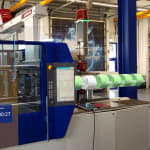
At the Fakuma 2021, Wittmann Battenfeld will show the complete presentation of a study on modern options of intuitive interaction with injection molding machines and parts removal robots. In a joint research project with several partners, the option of voice and gesture control of a Wittmann Battenfeld injection molding machine equipped with a B8 control system and a Wittmann robot fitted with R9 control software has been created.
In numerous test series, about 1500 typical phrases or voice commands (“utterances”) were defined, which an operator would use in order to test the entire production process for the loaded mold data in the semi-automatic mode and subsequently start up automatic production. To this end, operators wear a wireless headset, which they use for voice input of their commands.
Voice commands, such as “machine, start injection” or “robot, go to parts deposit position” or “robot, switch on vacuum”, are typical commands to be analyzed by a processing unit installed inside the production cell.
In this way, the realization is not based on data transmission to the cloud. All data remain inside the work cell and are processed there. Operators keep their hands free and can trigger the actions, without having to use the B8 terminal or to fall back on the robot’s R9 Teachbox.

Augmented barrel temperatures starting from nozzle temperature down to feed temperature (from left to right); fade-in and animation of the robot’s future program.
Parallel to manual control of the injection molding machine and the robot, production can be started and controlled inside the production cell. The operating elements of B8 can be addressed directly via the voice interface. This enables navigation to the corresponding page by the simple command “machine, show injection curve”.
Besides voice recognition, the research project also investigated new ways of interaction according to the concept of “mixed reality”. Here, it has been shown that using a pair of mixed reality glasses, in this special case a Microsoft Hololens 2, leads to a totally new experience for machine operators. Through these glasses, the operators will see the familiar environment at the beginning. The robot and the machine communicate with the glasses via an OPC UA interface specially created for this purpose. This makes it possible to fade in various objects and pieces of information, such as status reports and alarm signals, directly into the operator’s field of vision. Looking at the operating terminals of the injection molding machine and the robot is no longer necessary. Various safety areas, for example the areas around the tie-bars, are faded in three-dimensionally into the real world. The operator thus sees exactly where these are located and also perceives automatically how far away the robot is from such areas.
The production cell equipped with HoloVoice consists of a SmartPower 120 and a W918 robot. The possibilities of future operation via voice control and mixed reality can be presented at the Fakuma with the help of Wittmann Interactive.



